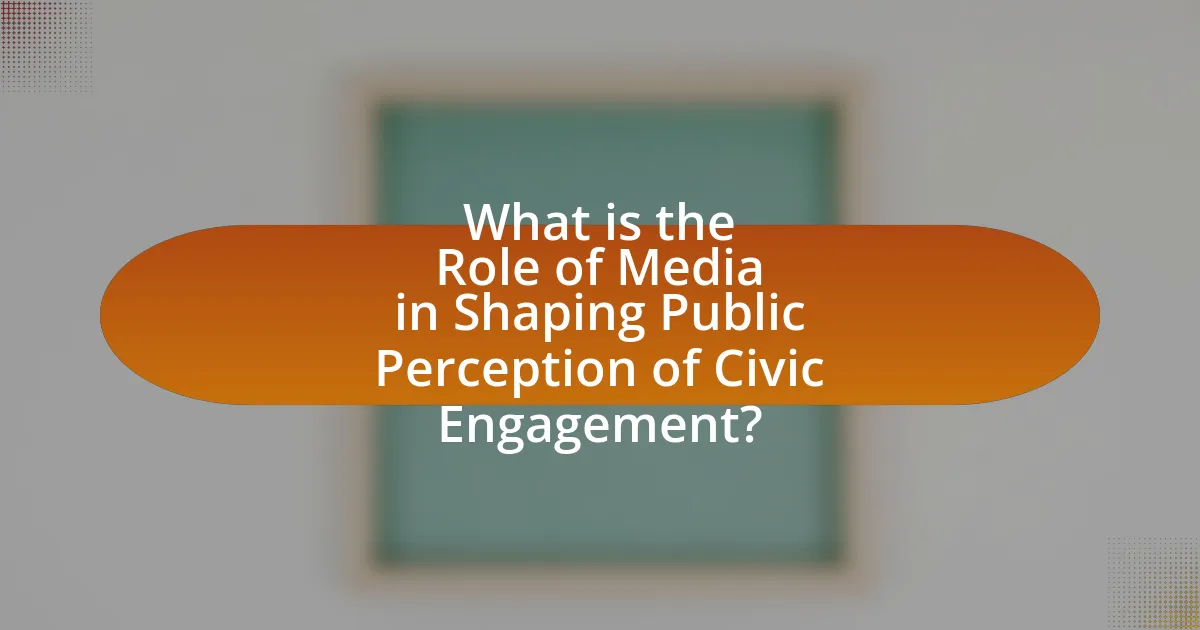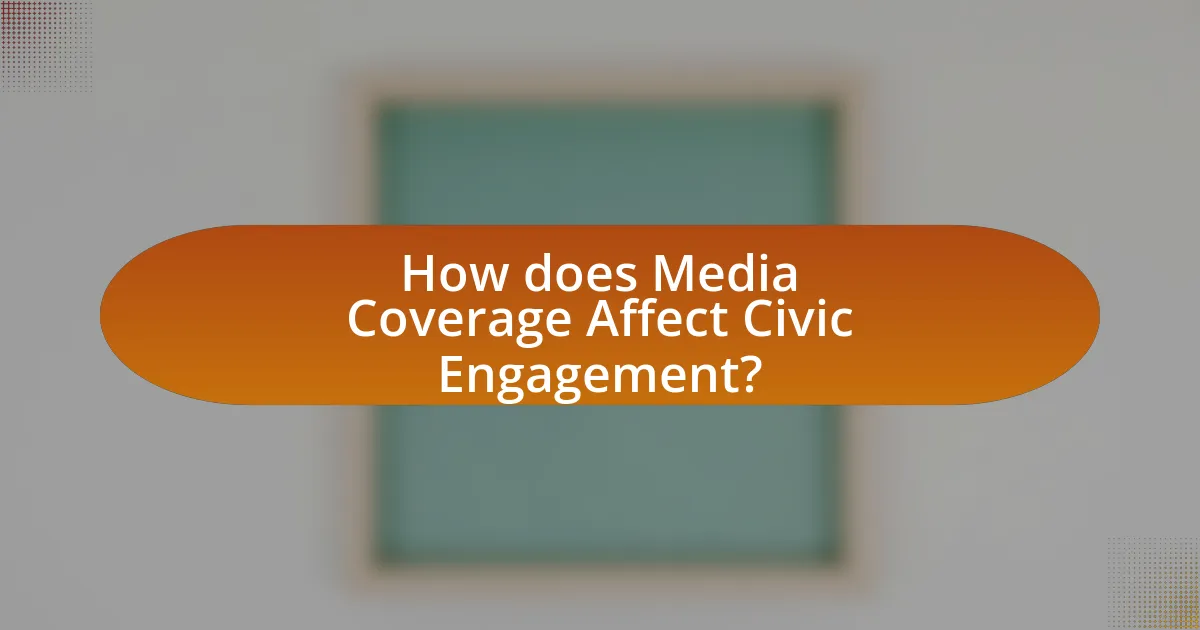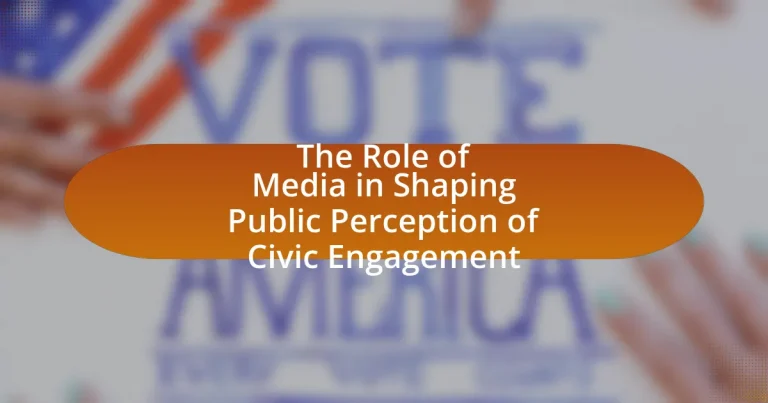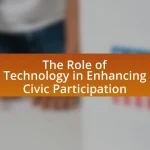The article examines the critical role of media in shaping public perception of civic engagement, highlighting how various media formats influence individuals’ understanding and participation in democratic processes. It discusses the impact of visual media, particularly social media and television, on public engagement levels and the importance of positive public perception in fostering civic participation. Additionally, the article addresses the consequences of negative perceptions, the influence of media coverage on civic activities, and strategies for enhancing media’s role in promoting civic engagement, including combating misinformation and improving media literacy. Overall, it underscores the significant relationship between media narratives and civic involvement in society.

What is the Role of Media in Shaping Public Perception of Civic Engagement?
The media plays a crucial role in shaping public perception of civic engagement by influencing how individuals understand and participate in democratic processes. Through news coverage, social media platforms, and public service announcements, media outlets highlight civic issues, mobilize communities, and frame narratives around participation. For instance, studies have shown that increased media exposure to civic activities correlates with higher voter turnout and community involvement, as evidenced by the 2018 U.S. midterm elections where media campaigns significantly increased engagement among younger voters. This demonstrates that the media not only informs the public but also actively shapes attitudes and behaviors related to civic participation.
How does media influence public understanding of civic engagement?
Media significantly influences public understanding of civic engagement by shaping narratives, providing information, and facilitating discussions around civic issues. Through various platforms, such as news outlets, social media, and community forums, media disseminates information about civic responsibilities, opportunities for participation, and the importance of civic engagement in a democratic society. For instance, studies have shown that exposure to civic-related content in media increases awareness and motivates individuals to participate in civic activities, such as voting or community service. Research conducted by the Pew Research Center indicates that individuals who engage with civic content are more likely to discuss political issues and participate in civic activities, demonstrating the media’s role in enhancing public understanding and involvement in civic engagement.
What types of media are most impactful in shaping perceptions?
Visual media, particularly social media platforms and television, are the most impactful in shaping perceptions. Research indicates that visual content is processed faster and more effectively by audiences, leading to stronger emotional responses and retention of information. For instance, a study by the Pew Research Center found that 64% of Americans believe social media has a significant impact on their views about political issues, demonstrating its power in influencing public perception. Additionally, television news remains a primary source of information for many, with studies showing that it shapes public opinion through framing and agenda-setting, further solidifying its role in perception formation.
How do different media formats affect public engagement levels?
Different media formats significantly influence public engagement levels by varying the accessibility, interactivity, and emotional resonance of content. For instance, visual media such as videos and infographics tend to capture attention more effectively than text-based formats, leading to higher engagement rates; studies show that social media posts with images receive 94% more views than those without. Additionally, interactive formats like polls and quizzes foster active participation, enhancing user involvement compared to passive consumption of traditional media. Research by the Pew Research Center indicates that 64% of Americans believe that social media has a positive impact on their ability to engage with civic issues, highlighting the role of digital platforms in facilitating public discourse.
Why is public perception of civic engagement important?
Public perception of civic engagement is important because it influences individuals’ willingness to participate in democratic processes. When the public views civic engagement positively, it can lead to higher voter turnout and increased involvement in community initiatives. Research indicates that communities with strong civic engagement are more likely to experience improved governance and social cohesion, as seen in studies by the National Civic League, which highlight the correlation between civic participation and community well-being. Thus, the perception of civic engagement directly impacts the health of democracy and community development.
What are the consequences of positive public perception?
Positive public perception leads to increased trust and support for organizations and individuals. This trust can result in enhanced reputation, which often translates into greater engagement from the community, increased participation in civic activities, and improved collaboration with stakeholders. For instance, a study by the Pew Research Center found that organizations perceived positively are more likely to receive community support and volunteer involvement, demonstrating a direct correlation between public perception and civic engagement outcomes.
How can negative perceptions hinder civic participation?
Negative perceptions can significantly hinder civic participation by fostering distrust and disengagement among community members. When individuals perceive civic institutions or processes as corrupt, ineffective, or unresponsive, they are less likely to engage in activities such as voting, volunteering, or attending public meetings. Research indicates that negative media portrayals of civic engagement can amplify these perceptions, leading to a cycle of apathy and disillusionment. For instance, a study by the Pew Research Center found that negative news coverage about government and civic organizations correlates with lower levels of public trust and participation in civic activities. This demonstrates that negative perceptions, often shaped by media narratives, can create barriers to active civic involvement.
What role do social media platforms play in civic engagement?
Social media platforms significantly enhance civic engagement by facilitating communication, mobilizing communities, and providing a space for public discourse. These platforms allow individuals to share information, organize events, and advocate for causes, thereby increasing participation in civic activities. For instance, a study by the Pew Research Center found that 69% of adults in the U.S. use social media, with many reporting that these platforms help them stay informed about political issues and connect with like-minded individuals. This connectivity fosters a sense of community and encourages collective action, demonstrating the vital role social media plays in promoting civic involvement.
How do social media campaigns influence public opinion?
Social media campaigns influence public opinion by rapidly disseminating information and shaping narratives through targeted messaging. These campaigns utilize algorithms to reach specific demographics, amplifying particular viewpoints and mobilizing users around social issues. For instance, a study by the Pew Research Center found that 69% of adults in the U.S. use social media, making it a powerful tool for influencing perceptions and behaviors. Additionally, social media platforms enable the viral spread of content, which can lead to significant shifts in public sentiment, as seen during movements like Black Lives Matter, where online engagement translated into real-world activism.
What are the risks associated with misinformation on social media?
Misinformation on social media poses significant risks, including the erosion of public trust, the spread of false narratives, and potential harm to public health and safety. The erosion of public trust occurs as individuals become skeptical of credible information sources, leading to a polarized society where misinformation thrives. For instance, a study by the Pew Research Center found that 64% of Americans believe that fabricated news stories cause confusion about the basic facts of current events. Additionally, the spread of false narratives can influence political opinions and voter behavior, as seen in the 2016 U.S. presidential election, where misinformation campaigns targeted specific demographics to sway electoral outcomes. Furthermore, misinformation related to health, such as false claims about vaccines, can lead to decreased vaccination rates and increased disease outbreaks, as evidenced by the resurgence of measles in areas with low vaccination coverage linked to anti-vaccine misinformation. These risks highlight the critical need for media literacy and fact-checking to mitigate the impact of misinformation on social media.

How does Media Coverage Affect Civic Engagement?
Media coverage significantly influences civic engagement by shaping public awareness and perceptions of social issues. When media outlets report extensively on specific topics, they can increase public interest and motivate individuals to participate in civic activities, such as voting or community organizing. For instance, a study by the Pew Research Center found that individuals exposed to news about civic issues are more likely to engage in discussions and take action related to those issues. Furthermore, media coverage can highlight the importance of civic participation, thereby fostering a sense of responsibility among citizens to engage in their communities.
What are the effects of media coverage on civic participation rates?
Media coverage significantly influences civic participation rates by increasing awareness and engagement among the public. Research indicates that extensive media coverage of civic issues, such as elections or social movements, correlates with higher voter turnout and participation in community activities. For instance, a study by the Pew Research Center found that individuals exposed to news about civic events were 50% more likely to participate in those events compared to those who were not. This effect is attributed to the media’s role in informing citizens, shaping public discourse, and mobilizing communities around specific causes.
How does the framing of news stories impact public perception?
The framing of news stories significantly impacts public perception by influencing how audiences interpret information and form opinions. Research indicates that the way a story is presented—through language, emphasis, and context—can shape viewers’ attitudes and beliefs about issues. For instance, a study by Entman (1993) highlights that framing can lead to different interpretations of the same event, such as portraying a protest as a “riot” versus a “demonstration,” which can affect public support for the cause. Additionally, framing can activate specific schemas in the audience’s mind, guiding their emotional responses and judgments. This demonstrates that media framing is a powerful tool in shaping civic engagement and public discourse.
What role does sensationalism play in shaping civic engagement?
Sensationalism significantly influences civic engagement by capturing public attention and driving emotional responses. This heightened emotional engagement can lead to increased participation in civic activities, as individuals are often motivated to act when they feel strongly about an issue. For instance, studies have shown that sensationalized news coverage of social issues, such as protests or political scandals, can lead to spikes in public involvement, as seen during the Black Lives Matter movement, where media portrayal amplified awareness and mobilization. Thus, sensationalism serves as a catalyst for civic engagement by transforming passive viewers into active participants through its compelling narratives.
How do local media outlets contribute to civic engagement?
Local media outlets contribute to civic engagement by providing essential information about community issues, events, and governance. They facilitate public discourse by covering local government meetings, reporting on civic initiatives, and highlighting community concerns, which encourages residents to participate in local decision-making processes. For instance, a study by the Pew Research Center found that local news significantly influences civic participation, with 62% of local news consumers reporting that they feel more informed about local issues. This increased awareness fosters a sense of community responsibility and motivates individuals to engage in civic activities such as voting, attending town hall meetings, and volunteering for local organizations.
What unique advantages do local media have in promoting civic issues?
Local media possess unique advantages in promoting civic issues due to their deep community connections and localized content focus. These media outlets often have a better understanding of local concerns, allowing them to tailor their reporting to reflect the specific needs and interests of their audience. For instance, local newspapers and radio stations frequently cover town hall meetings, local government decisions, and community events, which fosters greater public awareness and engagement in civic matters. Additionally, local media can facilitate dialogue among community members, creating a platform for discussion and debate on civic issues that directly affect residents. This localized approach not only enhances the relevance of the information presented but also encourages active participation in civic life, as evidenced by studies showing that communities with strong local media engagement report higher levels of civic involvement and voter turnout.
How can local media foster community involvement?
Local media can foster community involvement by providing platforms for dialogue and engagement among residents. By covering local events, issues, and initiatives, local media encourages citizens to participate in community activities and discussions. For instance, studies show that community newspapers that highlight local volunteer opportunities and civic events can increase participation rates by up to 30%. Furthermore, local media can facilitate forums and discussions that allow residents to voice their opinions and collaborate on solutions, thereby enhancing civic engagement and community cohesion.
What Strategies Can Enhance Media’s Role in Civic Engagement?
To enhance media’s role in civic engagement, strategies such as promoting participatory journalism, leveraging social media platforms for community dialogue, and providing accessible information on civic issues are essential. Participatory journalism encourages citizens to contribute to news stories, fostering a sense of ownership and involvement in civic matters. For instance, platforms like GroundSource allow community members to share their perspectives, which can lead to more inclusive reporting. Leveraging social media enables real-time discussions and mobilization around civic issues, as seen in movements like Black Lives Matter, which utilized Twitter to organize and inform. Additionally, providing accessible information, such as voter registration details and local government resources, empowers citizens to engage actively in their communities, as evidenced by initiatives like Vote.org, which simplifies the voting process. These strategies collectively strengthen the media’s capacity to engage the public in civic life.
How can media organizations improve their coverage of civic issues?
Media organizations can improve their coverage of civic issues by prioritizing in-depth reporting and community engagement. In-depth reporting allows for a comprehensive understanding of civic issues, enabling journalists to provide context, background, and diverse perspectives. For instance, a study by the Pew Research Center found that local news outlets that focus on investigative journalism significantly enhance public awareness and understanding of civic matters. Additionally, engaging with the community through forums, surveys, and social media can help media organizations gather insights directly from citizens, ensuring that coverage reflects the concerns and needs of the public. This approach not only fosters trust but also encourages civic participation, as evidenced by increased voter turnout in areas with robust local journalism.
What best practices should media follow to promote civic engagement?
Media should prioritize transparency, accuracy, and inclusivity to effectively promote civic engagement. By providing clear and factual information about civic issues, media can empower citizens to participate in democratic processes. For instance, studies show that accurate reporting on local elections increases voter turnout by up to 20%. Additionally, media should create platforms for diverse voices, ensuring representation of marginalized communities, which fosters a more engaged citizenry. Research indicates that inclusive media coverage correlates with higher levels of public participation in civic activities.
How can collaboration between media and civic organizations be beneficial?
Collaboration between media and civic organizations can enhance public awareness and engagement in social issues. This partnership allows civic organizations to leverage media platforms for broader outreach, effectively communicating their missions and initiatives to a larger audience. For instance, studies have shown that media coverage of civic activities can increase participation rates in community events by up to 30%, as reported in the “Civic Engagement and Media” research by the Pew Research Center. Additionally, media can provide civic organizations with critical visibility, helping to attract funding and support, which is essential for their sustainability and impact.
What are effective ways to combat misinformation in media?
Effective ways to combat misinformation in media include promoting media literacy, fact-checking, and encouraging transparency from media organizations. Media literacy programs educate individuals on how to critically evaluate sources and discern credible information, which is essential in an age of information overload. Fact-checking initiatives, such as those by organizations like PolitiFact and FactCheck.org, provide verified information and debunk false claims, thereby reducing the spread of misinformation. Additionally, media organizations can enhance trust by being transparent about their sources and editorial processes, which fosters accountability and encourages responsible reporting. These strategies collectively contribute to a more informed public and a healthier media landscape.
How can media literacy programs empower the public?
Media literacy programs empower the public by equipping individuals with critical thinking skills necessary to analyze and evaluate media content. These programs teach participants how to discern credible information from misinformation, thereby fostering informed decision-making and active civic engagement. Research indicates that individuals who participate in media literacy initiatives demonstrate improved abilities to identify biased reporting and recognize persuasive techniques used in media, which enhances their capacity to engage thoughtfully in democratic processes. For instance, a study by the National Association for Media Literacy Education found that students who underwent media literacy training showed a 30% increase in their ability to critically assess news sources.
What practical steps can individuals take to engage with media for civic participation?
Individuals can engage with media for civic participation by actively consuming, sharing, and creating content that promotes civic issues. This includes following reputable news sources, participating in discussions on social media platforms, and utilizing tools like blogs or podcasts to express their views. Research indicates that individuals who engage with diverse media sources are more informed about civic matters, which enhances their ability to participate effectively in democratic processes. For example, a study by the Pew Research Center found that 62% of social media users have engaged in civic activities as a result of content they encountered online.


